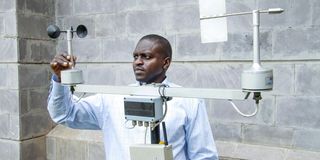Agronomist notebook: The beauty of having on-farm weather station

Tom Okinja, a senior meteorologist demonstrates how an automatic weather station works in Nairobi. To minimise losses due to unpredictable changes of weather conditions, farmers need to embrace the concept of automatic weather stations. PHOTO | FILE | NATION MEDIA GROUP
What you need to know:
- It will help you do everything with precision from planting to spraying and harvesting
- To minimise losses due to unpredictable change of weather conditions, farmers need to embrace automatic weather stations.
- The gadget has sensors that check for the weather conditions and automatically sends information to one’s phone.
- Transplanting should also be avoided when the temperatures are high as the seedlings suffer from shock.
Good crop production directly depends on the prevailing weather conditions, even if one uses irrigation.
In the greenhouse, one can easily control environmental conditions for better crop growth, but in the field, this is a big challenge.
Traditionally, farmers observed movement of birds and animals for timely planting. Nowadays, a majority of farmers rely on forecasts from the weatherman, which sometimes turn out to be inaccurate.
Perhaps this is because the meteorological department gives a broader weather forecast that may not cater for the micro-climates of some regions. Climate change has also made weather patterns erratic.
To minimise losses due to unpredictable change of weather conditions, farmers need to embrace automatic weather stations.
This gadget has greatly improved analysis and documentation of weather data.
It also helps in predicting anticipated weather conditions, which may cause pest and disease infestation, determining the most suitable crop for a given time and safeguards crops against adverse environmental conditions such as excess rainfall.
I visited a farm last week in Kisaju, Kajiado County, which has installed an automatic weather station and I was amazed by the technology.
CHECK FOR WEATHER CONDITIONS
The gadget has sensors that check for the weather conditions and automatically sends information to one’s phone.
According to Muriuki, the farm manager, it checks air and soil temperature, wind direction and speed, humidity, sunshine and precipitation.
When spraying, this device gives him adequate information on wind speed since it has an anemometer attached to it.
He is, therefore, able to determine when to spray the crops with less chemical drift.
If it’s too hot and the temperatures are high, the farmer should not spray the crops since this can easily lead to scorching effect.
Transplanting should also be avoided when the temperatures are high as the seedlings suffer from shock.
During rainy conditions, the farmer should avoid spraying since the chemical is easily washed away. In case one has to spray, then he should include a wetter (and a sticker) to prevent the chemical from being washed off.
Application of soluble fertilisers during the wet season can give two results, first they can be washed away or they get leached hence not helpful to the plant.
The gadget, which goes for between Sh60,000 and Sh100,000 can also easily determine the amount of rainfall received in a given duration since it has the rain gauge.
This enables him to understand the crop water requirement and determine if he should irrigate or not.
SENT TO THE PHONE
Also, when the temperatures are high, the automatic weather station will tell you so that you increase the frequency of watering due to the high rate of evaporation resulting in water loss.
The machine’s sensor in the soil helps to measure the moisture, and the nutrients available. One thus applies the correct rates of fertiliser, nutrients form and on time as required by the plant.
This reduces wastage hence increased crop production. The weather forecasts also ensure that the fertiliser is applied in the right conditions when the soil is wet.
All these information is sent to the phone making it faster for the farmer to receive and understand the weather conditions and respond accordingly.
When installing a weather station on your farm, consider the climatic and soil conditions and the type of crop to be planted.
In an automatic greenhouse, sensors are used to regulate the opening and closing of the vents for accurate temperatures.
Well, smallholders may find the gadget costly, thus must follow the advice from the meteorological department keenly.
They should also keep records of the previous cropping season as these offer guidance in making decisions on the kind of crop to grow depending on the market demand and trends.





